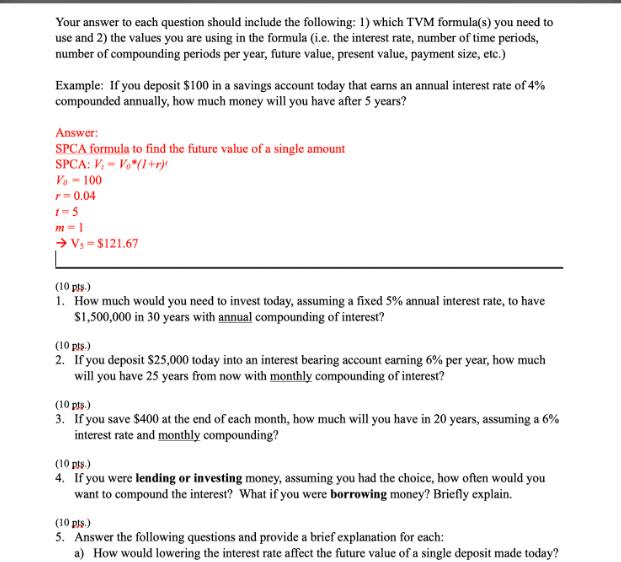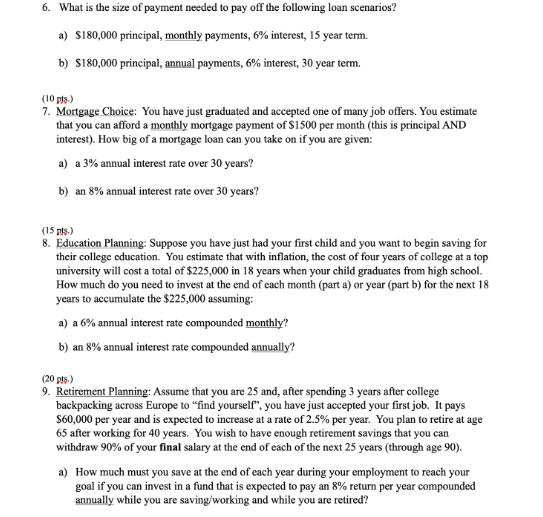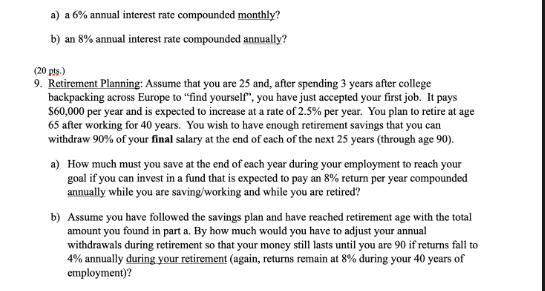Answered step by step
Verified Expert Solution
Question
1 Approved Answer
Your answer to each question should include the following: 1) which TVM formula(s) you need to use and 2) the values you are using



Your answer to each question should include the following: 1) which TVM formula(s) you need to use and 2) the values you are using in the formula (i.e. the interest rate, number of time periods, number of compounding periods per year, future value, present value, payment size, etc.) Example: If you deposit $100 in a savings account today that earns an annual interest rate of 4% compounded annually, how much money will you have after 5 years? Answer: SPCA formula to find the future value of a single amount SPCA: V-Vo*(1+r) V-100 -0.04 1-5 m=1 Vs-$121.67 (10 pts.) 1. How much would you need to invest today, assuming a fixed 5% annual interest rate, to have $1,500,000 in 30 years with annual compounding of interest? (10 pts.) 2. If you deposit $25,000 today into an interest bearing account earning 6% per year, how much will you have 25 years from now with monthly compounding of interest? (10 pts.) 3. If you save $400 at the end of each month, how much will you have in 20 years, assuming a 6% interest rate and monthly compounding? (10 pts.) 4. If you were lending or investing money, assuming you had the choice, how often would you want to compound the interest? What if you were borrowing money? Briefly explain. (10 pts.) 5. Answer the following questions and provide a brief explanation for each: a) How would lowering the interest rate affect the future value of a single deposit made today? 6. What is the size of payment needed to pay off the following loan scenarios? a) $180,000 principal, monthly payments, 6% interest, 15 year term. b) $180,000 principal, annual payments, 6% interest, 30 year term. (10 pts.) 7. Mortgage Choice: You have just graduated and accepted one of many job offers. You estimate that you can afford a monthly mortgage payment of $1500 per month (this is principal AND interest). How big of a mortgage loan can you take on if you are given: a) a 3% annual interest rate over 30 years? b) an 8% annual interest rate over 30 years? (15 pts.) 8. Education Planning: Suppose you have just had your first child and you want to begin saving for their college education. You estimate that with inflation, the cost of four years of college at a top university will cost a total of $225,000 in 18 years when your child graduates from high school. How much do you need to invest at the end of each month (part a) or year (part b) for the next 18 years to accumulate the $225,000 assuming: a) a 6% annual interest rate compounded monthly? b) an 8% annual interest rate compounded annually? (20 pts.) 9. Retirement Planning: Assume that you are 25 and, after spending 3 years after college backpacking across Europe to "find yourself", you have just accepted your first job. It pays $60,000 per year and is expected to increase at a rate of 2.5% per year. You plan to retire at age 65 after working for 40 years. You wish to have enough retirement savings that you can withdraw 90% of your final salary at the end of each of the next 25 years (through age 90). a) How much must you save at the end of each year during your employment to reach your goal if you can invest in a fund that is expected to pay an 8% return per year compounded annually while you are saving/working and while you are retired? a) a 6% annual interest rate compounded monthly? b) an 8% annual interest rate compounded annually? (20 pts.) 9. Retirement Planning: Assume that you are 25 and, after spending 3 years after college backpacking across Europe to "find yourself", you have just accepted your first job. It pays $60,000 per year and is expected to increase at a rate of 2.5% per year. You plan to retire at age 65 after working for 40 years. You wish to have enough retirement savings that you can withdraw 90% of your final salary at the end of each of the next 25 years (through age 90). a) How much must you save at the end of each year during your employment to reach your goal if you can invest in a fund that is expected to pay an 8% return per year compounded annually while you are saving/working and while you are retired? b) Assume you have followed the savings plan and have reached retirement age with the total amount you found in part a. By how much would you have to adjust your annual withdrawals during retirement so that your money still lasts until you are 90 if returns fall to 4% annually during your retirement (again, returns remain at 8% during your 40 years of employment)?
Step by Step Solution
There are 3 Steps involved in it
Step: 1
To find the present value for the first question we would use the Time Value of Money TVM formula for present value of a single amount PV FV 1 rn In t...
Get Instant Access to Expert-Tailored Solutions
See step-by-step solutions with expert insights and AI powered tools for academic success
Step: 2

Step: 3

Ace Your Homework with AI
Get the answers you need in no time with our AI-driven, step-by-step assistance
Get Started


